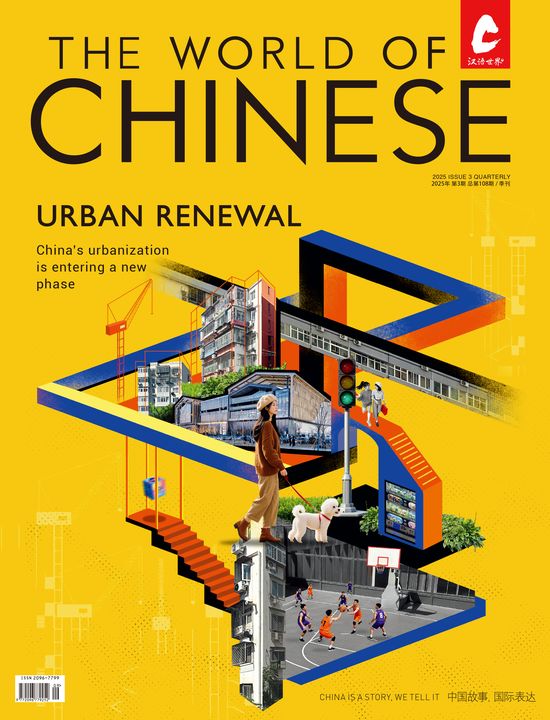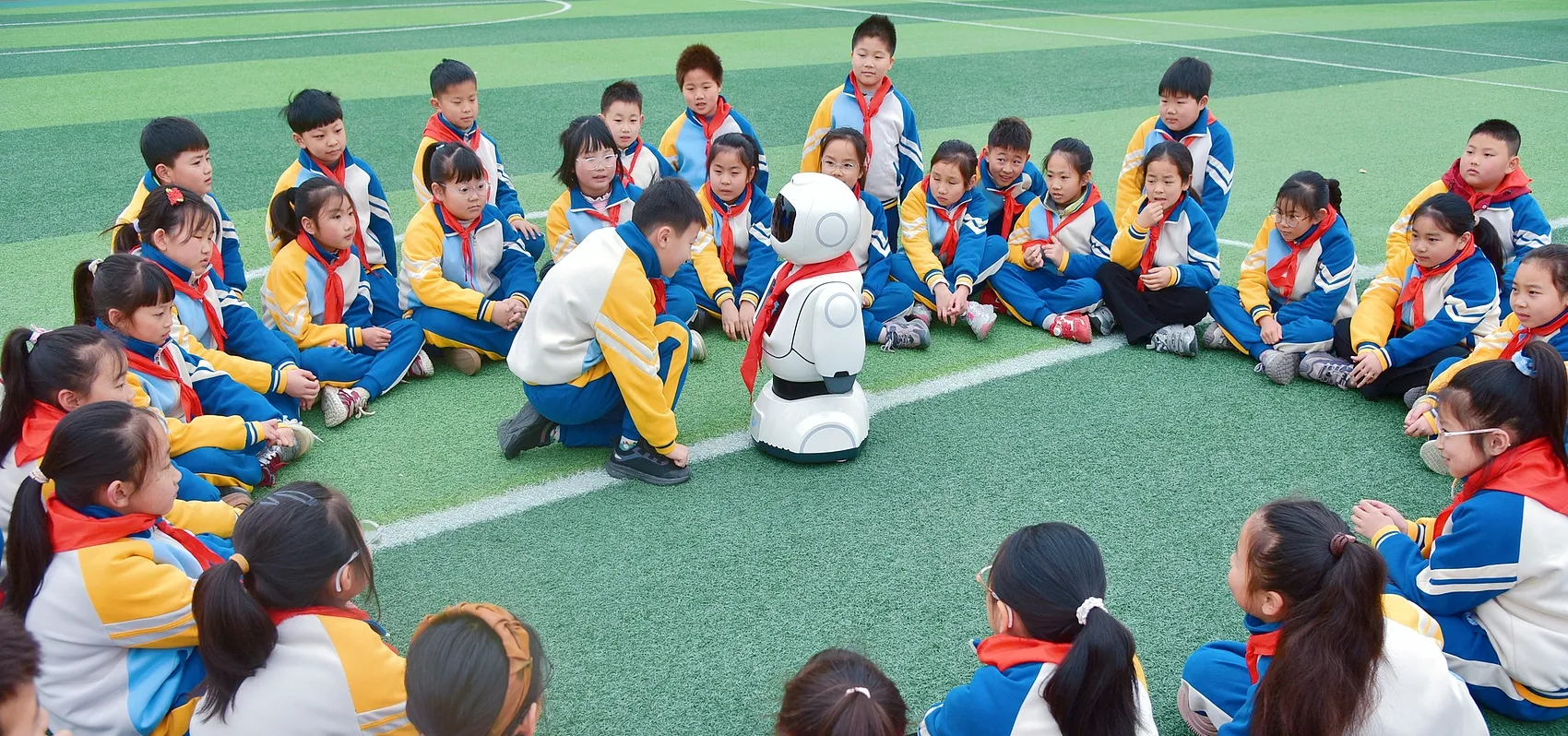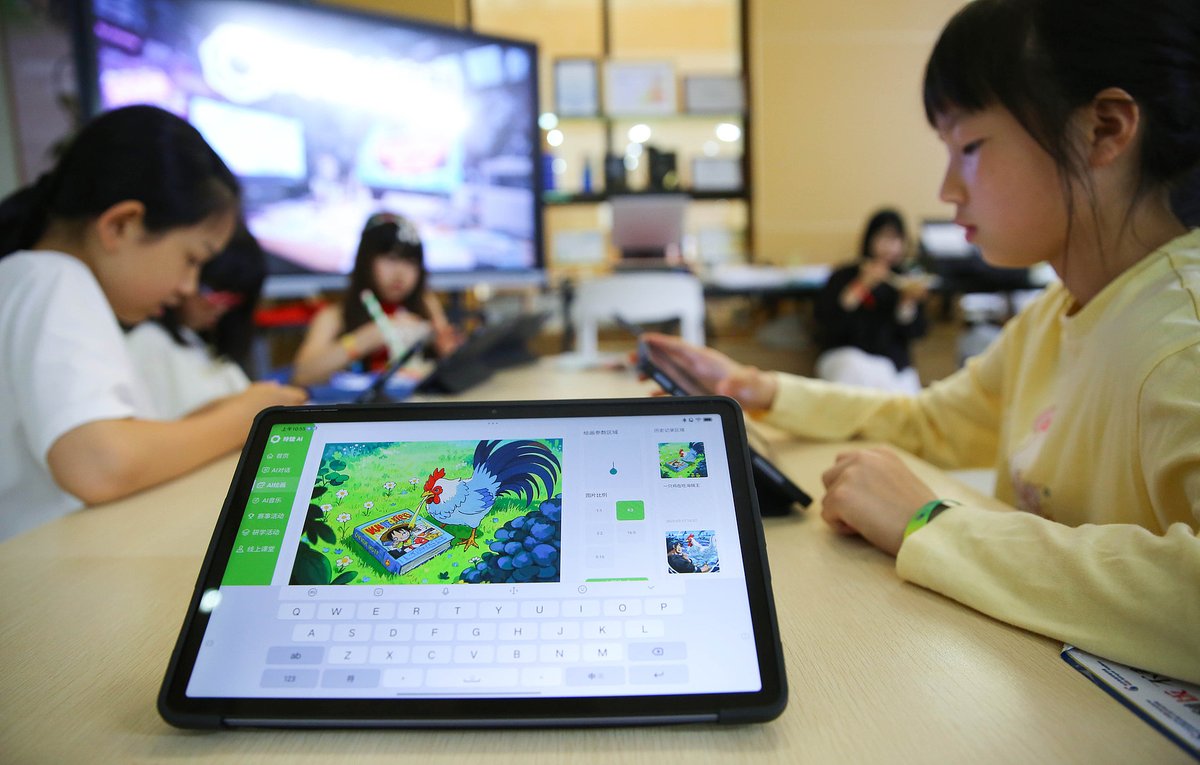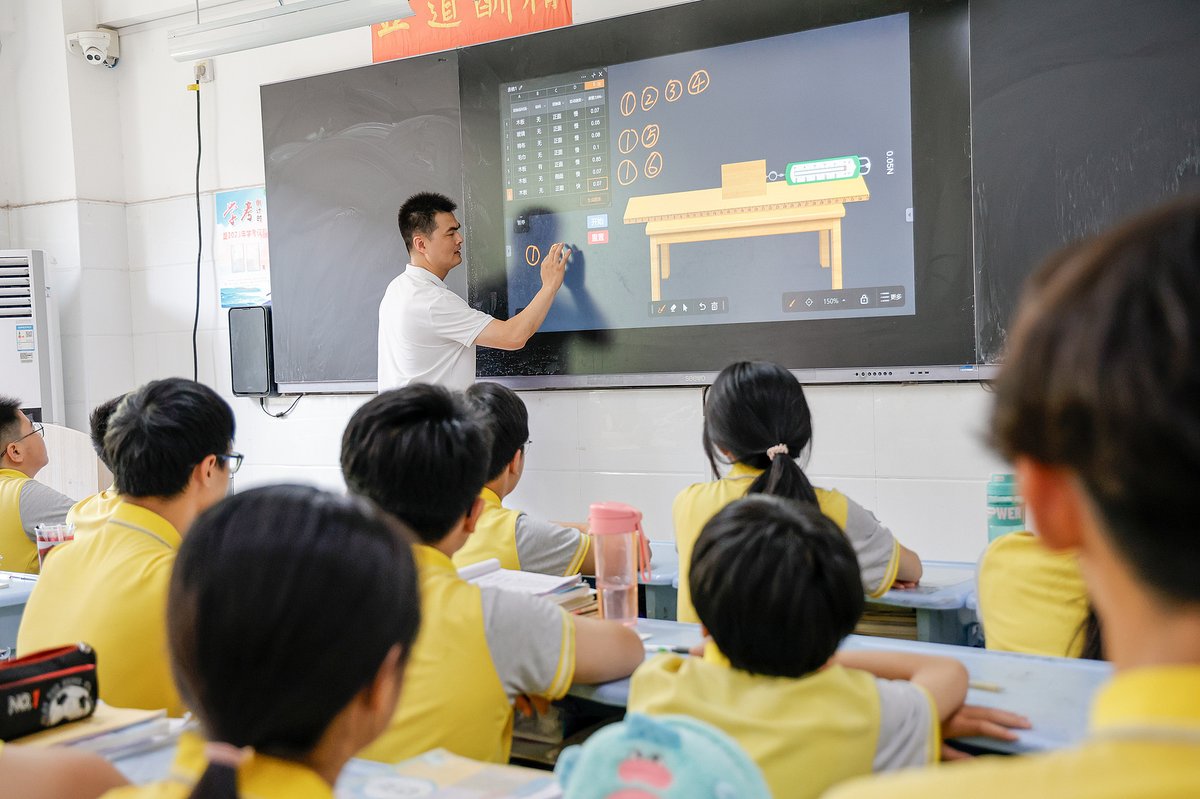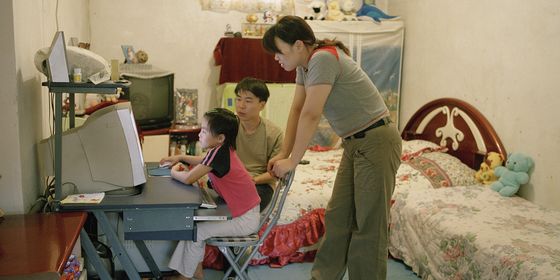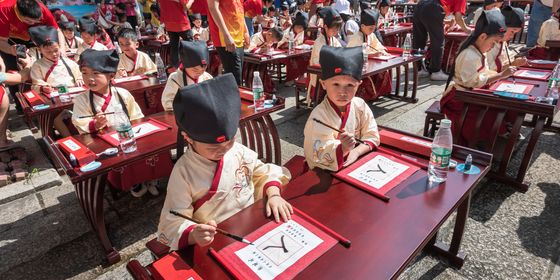Chinese schools are rushing to introduce artificial intelligence into the classroom, challenging students and teachers to keep pace
In a science class somewhere in China, a group of sixth-graders is having a conversation across time. One boy asks astronomer Zhang Heng (张衡), who lived in the 2nd century, about what motivated him to invent the world’s first seismograph. Another wonders whether Nicolaus Copernicus felt afraid to propose that the Earth rotated around the Sun, rather than the other way around, like everyone else thought.
As the teacher makes a few clicks on the tablet, these centuries-old figures begin speaking to the children via text generated by the AI language model DeepSeek. Later, the students work with AI to generate images of ancient Chinese history and mythology, drawing on their own knowledge and imagination, ranging from the mythical goddess Nüwa (女娲) mending the sky to the 11th-century poet Su Shi (苏轼) writing verses about the moon.
This is a real-life simulation of a “class of the future” presented at Tianjin’s China Educational Equipment Exhibition this April by leading education tech company Shirui Electronics. For Su Xiaoling, an elementary school vice-principal attending the event all the way from southeastern China’s Fujian province, these scenes are not unfamiliar. Su tells TWOC that since last year, teachers at her school have started to integrate AI into their work, using it to prepare lessons, review assignments, and make similarly creative simulations of historical figures to engage students in their learning.
Interest in AI applications in the education and other sectors has surged over the past year or two. Last November, China’s Ministry of Education (MOE) vowed to make AI education “the norm” in elementary and secondary schools by 2030. In many schools, this is already the reality.
Discover more about Chinese education:
- No Time to Teach
- Primal Fear: Why China’s Children Are Becoming More Nature-Averse
- Parallel Worlds: How A Lifestyle App Shed Light on China’s Education Gap
Having frequently applied AI in her classroom this year, Fang Qi, a kindergarten teacher from eastern China’s Anhui province, praises artificial intelligence as a great “helper.” It relieves her from the time-consuming paperwork and other routine formalities, such as writing social media posts for the school’s accounts or drafting safety plans for emergencies, which teachers are increasingly burdened with by educational authorities. “It used to take us at least a day to write a report on a class activity [for social media], but now we can do it in an hour or so by giving information to AI, setting a word count, and then editing the report it generates,” the 32-year-old teacher, who agreed to be interviewed under a pseudonym, tells TWOC.
He Yanan, an elementary school Chinese teacher from northern China’s Inner Mongolia region, shares a similar outlook on AI tools. In her sixth-grade class, some students have struggled with essay writing, often due to limited reading skills, especially while taking online courses during the pandemic. Previously, she had to guide them through multiple rounds of revisions for a single piece. Now, she says, “By inputting the students’ original writing, AI can generate a more structured version for them to learn from through comparison and imitation.” This, she notes, helps improve their organization and structure while also boosting their confidence. She’s also open to parents using ByteDance’s AI chatbot Doubao or similar tools to support their children’s writing.
Huang Jia, a Chinese and homeroom teacher at a high school in Foshan, Guangdong province, on the other hand, has become less enchanted with AI since she started using it three years ago. “AI helps mainly with the chores, including writing news releases [for the school’s publicity] and communicating with parents, rather than teaching,” she concludes.
For the pedagogical part of her work, Huang has tried using DeepSeek, but feels the plan suggestions are “impractical” and “useless.” The 28-year-old, who agreed to be interviewed under a pseudonym, was initially excited when the language model designed an interactive game using internet slang to explain poetic imagery. But her excitement soon faded when she realized the plan didn’t meet current teaching standards, largely due to a lack of relevant training data on existing lesson plans.
She then tried to use AI for essay grading, but “scanning and uploading all the essays and writing detailed prompts for review took so much time I could have graded many of them myself,” she says, adding that that the free version she used could only review five essays at a time, so she had to repeat the process 20 times to mark all 100 students in the two classes she taught. “[The server] is always busy and slow.” She then had to repeat the process with other AI models, such as Doubao and Kimi, to cross-check the results, adding more time to the already exhausting practice.
“It would be better if the school could purchase education-specific AI tools...[Implementing AI in education] shouldn’t rely solely on teachers’ efforts and free AI services,” Huang suggests. “The school should establish a student database that could generate one-on-one study materials for each student.”
Huang is not alone. Another teacher recently shared on the social media platform RedNote that she spent an entire night trying to use free apps to create an AI avatar that could read text aloud—only to fail. Her post drew hundreds of comments from fellow teachers, many of whom are also struggling with school mandates to incorporate AI-generated content into their lessons without proper training, guidance, or access to paid tools.
While the technology is advancing fast, calls for going back to traditional learning are also growing louder. This April, a poll of over 4,200 parents nationwide found that one-third supported the idea of bringing back traditional blackboards in the classroom to replace screens. As early as 2021, the MOE banned students from bringing mobile phones to school, citing addiction and eye health concerns.
Teachers are also sounding the alarm over students using AI to plagiarize. Huang has caught several AI-generated assignments handed in by students this year. When presenting a book report, one student introduced well-known modern writer Wang Zengqi as a botanist—a typical AI hallucination likely based on the title of Wang’s prose collection, roughly translated as Grass and Trees of the Earth. Huang asserts that she can spot AI-generated essays at a glance, describing them as “empty content loaded with fancy phrases that aren’t consistent with a high school student’s style,” often filled with “typical words AI uses.”
To address this issue, the MOE issued two guidelines on AI education in May to promote AI literacy while preventing AI abuse. Schools are to introduce courses on the basic concepts, technical principles, and ethical and security issues of AI, while students are prohibited from copying AI-generated content for assignments or exams. It is unclear how this prohibition will be enforced or how it might add to the already heavy burden on teachers, who, along with parents, are deemed by the MOE to be responsible for nurturing students’ creativity and critical thinking.
Qualified teachers, adequate facilities, and sufficient funding remain major obstacles to mainstreaming AI education and ensuring its ethical use in China’s schools. Vice principal Su, for one, doesn’t find it realistic for her small school of around 2,000 students in Fujian to utilize AI in the way presented at the exhibition. “It’s unlikely for us, and probably the majority of schools, to have one tablet for each student that can cater to their individual needs,” she says.
The lack of devices and funds to popularize AI in education is particularly noticeable in rural and economically disadvantaged regions. Jiang Bo, deputy president of the Institute of AI Education at East China Normal University, noted in March that while some classes in Shanghai boasted one tablet for every two students, computers or computer rooms were still luxuries in other parts of the country, contributing to growing educational inequalities.
The lack of qualified teachers presents another obstacle to bringing AI into classrooms. According to a report jointly released by Tencent, East China Normal University, and China National Academy of Educational Sciences, as of 2022, only one-third of teachers who are supposed to teach AI literacy courses to students had received relevant training. In many schools, science and information science teachers, who typically studied computer science in college, are assigned to teach AI-related knowledge to both teachers and students. Some schools have even tried outsourcing AI-tutoring to specialized companies.
AI researcher Zhang Yizhen has welcomed elementary school students from Shanghai to his Beijing workshop, where they can explore a range of AI gadgets designed to support the elderly, children, and people with disabilities, giving young visitors a broader perspective on the ethical and human-centered dimensions of the technology. He feels that AI literacy should go beyond knowledge of how to use the latest model. He hopes to develop courses in the future that can help students build critical thinking skills, learning to evaluate information generated by AI and use it as a tool to bring their own ideas and creativity to life. “Currently, there are few such courses in China…and most quality resources are in English,” says Zhang. His startup, founded just a year ago, currently offers free AI lectures on its video channel, with titles like “How Large Language Models Work” and “Will People Lose Their Jobs Because of AI?”
Zhang is optimistic about the future of AI education in China. “The key lies in technological breakthroughs [like DeepSeek]…When more user-friendly products emerge, more people will be driven to learn and use them,” he points out, believing the next leap is just a couple of years away. “Just look at [how much has changed] in the past three years.”
But frontline teachers remain skeptical. Huang has stopped using AI tools to grade essays, finding the process too complicated to be worthwhile in terms of saving time. She’s also concerned that students’ personal data could be leaked without consent, given the current lack of laws or mechanisms to ensure data security.
Su also cautions against the potential “fever” to roll out AI education nationwide without fully accounting for the diverse realities across regions and schools. Though she does acknowledge that AI education in China is destined to become a lifelong, society-wide undertaking. “It’s not just a single course with an exam at the end,” she says.
Are China’s Schools Ready for the Onslaught of AI? is a story from our issue, “Smart Nation.” To read the entire issue, become a subscriber and receive the full magazine.
